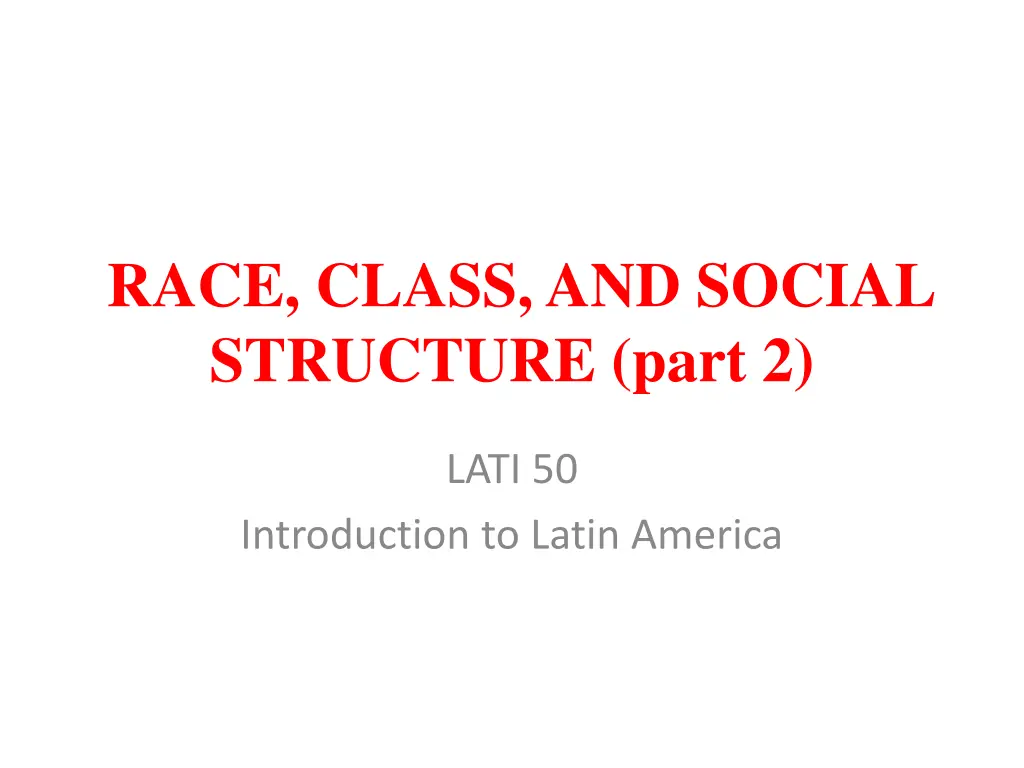
Latin America: Race, Class, Social Structure Exam Details & Study Guide
Prepare for the Latin America course's midterm exam covering topics like social classes, historical figures, revolutions, and democratization trends. Understand the class structure, racial issues, and independence movements in the region with key readings and comparisons provided as study guides.
Uploaded on | 0 Views
Download Presentation

Please find below an Image/Link to download the presentation.
The content on the website is provided AS IS for your information and personal use only. It may not be sold, licensed, or shared on other websites without obtaining consent from the author. If you encounter any issues during the download, it is possible that the publisher has removed the file from their server.
You are allowed to download the files provided on this website for personal or commercial use, subject to the condition that they are used lawfully. All files are the property of their respective owners.
The content on the website is provided AS IS for your information and personal use only. It may not be sold, licensed, or shared on other websites without obtaining consent from the author.
E N D
Presentation Transcript
RACE, CLASS, AND SOCIAL STRUCTURE (part 2) LATI 50 Introduction to Latin America
ABOUT THE MIDTERM (i) Coverage: Weeks 1-5 Grade share: 33% (without optional paper) Format: closed-book exam (no electronic devices) Date: Thursday, February 17 (in class) Duration: 80 minutes (3:30-4:50 pm) Bring blue books and writing materials
ABOUT THE MIDTERM (ii) Readings: Modern Latin America, introduction + chapters 1-5, 7-10, 12-13 MLA website, Documents 3, 6, 10, 14 Garc a M rquez, Chronicle of a Death Foretold Videos: Garden of the Forking Paths Fire in the Mind Class Notes: Lectures 1-10
STUDY GUIDE (a) Identify and state the significance of: Santiago Nasar Bayardo San Rom n Francisco Madero Evita Per n The boom ISI C sar Augusto Sandino Mestizaje Platt Amendment NAFTA Bureaucratic-authoritarian regimes Augusto Pinochet
STUDY GUIDE (b) Compare the Spanish American path to independence with that of Brazil. What difference did it make? How does Chronicle of a Death Foretold exemplify the phenomenon of magical realism ? Compare the Mexican Revolution with the Cuban Revolution. Compare economic strategies in Chile and Argentina. Describe Latin America s patterns of democratization during the course of the twentieth century. What are the implications of these trends?
CLASS STRUCTURE Upper Class: Urban (industrialists, bankers) Rural (landowners) Middle Class: Urban (merchants, lawyers, etc.) Rural (small farmers) Popular/Lower Class: Urban (workers) Rural (peasants, campesinos) National Institutions: State (including military) Church External Sector: Economic (investors, merchants) Political (foreign governments)
SHADINGS BY RACE Race as a social construct Indigenous peoples: exploitation and discrimination African-origin peoples and slavery Myths of miscegenation: Mestizaje Mulattos and Brazilian escape hatch
THE DOMINICAN REPUBLIC Shares island of Hispaniola with Haiti A plantation society (sugar and slaves) 1916-24 U.S. military occupation 1930-61 Rafael Le nidas Trujillo in power 1965 U.S. military intervention 1966-78 Joaqu n Balaguer in power 1978- electoral democracy
THE QUESTION OF RACE population of mixed African-European descent Cultural and social stratification: white > black Antagonism with Haiti (occupation 1822-44), uncertainty over identity Trujillo cult of hispanidad, defining Dominicans as the most Spanish people of America 1992 celebration of discovery and evangelization of America Reassessment of African legacy?
